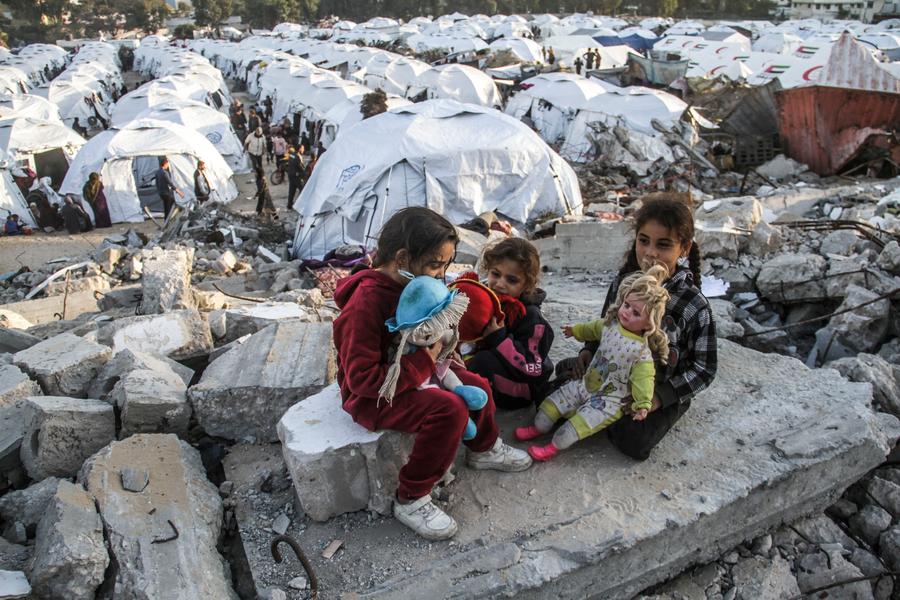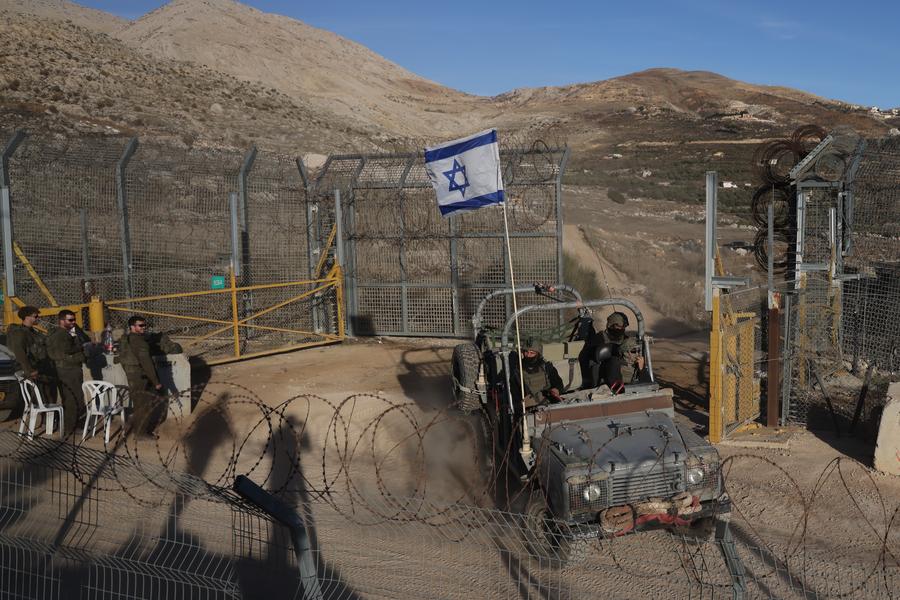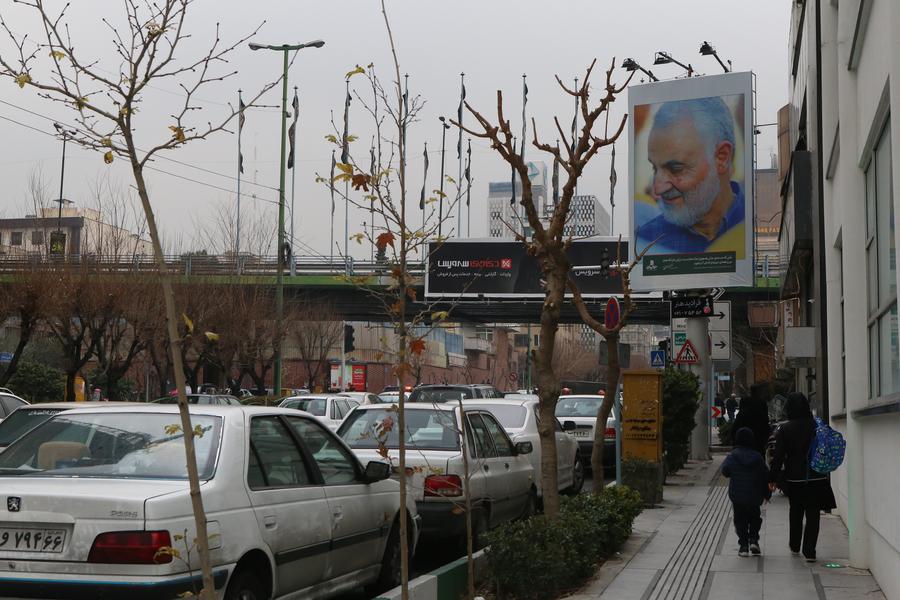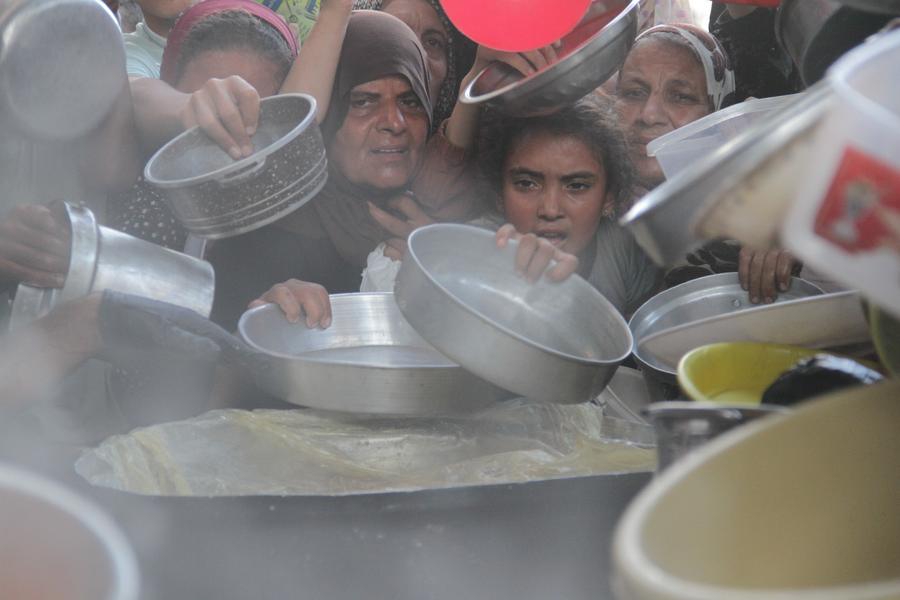
.jpg)
Displaced Palestinian children play at a shelter in Gaza City on Dec. 9, 2024. (Photo by Mahmoud Zaki/Xinhua)
The escalating crises in the Middle East over the passing year have deepened human tragedies, geopolitical shifts, and socioeconomic challenges, leaving the region's prospects for 2025 shrouded in uncertainty.
In a region where turmoil has long been the norm, the cascade of events in the Middle East in 2024 has nevertheless shocked the world due to its intensity and complexity.
The Israel-Palestine conflict entered the second year, leaving Gaza stranded in a dire humanitarian crisis and creating ripple effects across Lebanon, Yemen and Iran. Apart from Israel's multiple-front wars, the escalating fighting in Sudan, rising instability in Libya, as well as the swift toppling of Bashar al-Assad's government in Syria, have created further chaos in the Middle East.
The human tragedies, geopolitical shifts and socioeconomic challenges befalling the region throughout the year have cast a shadow over the future of the Middle East in 2025.
INCREASING HOSTILITIES
As mediators are still working to bridge the chasm between Israel and Palestine to create a Gaza ceasefire deal through indirect negotiations, Israel is launching more airstrikes and bombardment on the brittle enclave.
The 14-month conflict has claimed more than 45,300 Palestinian lives and injured nearly 108,000 others, according to Gaza's health authorities. The UN estimates that, as of early December, over 1.6 million people were living in makeshift shelters, with 80 percent of Gaza under ongoing evacuation orders since October.
"There is nowhere that civilians in Gaza are safe," Tom Fletcher, UN under-secretary-general for humanitarian affairs and emergency relief coordinator, said Monday, noting that more humanitarians in Gaza have been killed in 2024 than any on record.
The conflict in Gaza, the "eye of the storm," has also spread to neighboring regions, raising concerns that the Middle East is teetering on the brink of a wider regional war.
Israel's airstrike on the Iranian Embassy in Syria in April prompted Iran to retaliate with a large-scale drone and missile assault on Israel and triggered further tit-for-tats between the two sides. Israel then killed Hamas Politburo Chief Ismail Haniyeh in July and Hezbollah leader Sayyed Hassan Nasrallah in September. In the following month, Israeli tanks crossed the border and advanced onto Lebanese soil.
Despite a fragile ceasefire between Israel and Hezbollah, effective from Nov. 27 and aimed at ending a conflict that have reportedly claimed more than 4,000 lives in Lebanon, Israeli forces have continued their strikes, causing further casualties.
Following a 12-day military operation by Syrian militant groups that resulted in the fall of al-Assad's government on Dec. 8, Israel launched extensive airstrikes on Syria and moved its troops into a demilitarized zone near the Israeli-occupied Golan Heights. As the year comes to an end, Israel has vowed to "act with force" against the Houthis in Yemen amid heavier exchanges of fire between the two sides.
.jpg)
 Israeli troops are seen near the buffer zone in the Golan Heights, on Dec. 15, 2024. (Photo by Jamal Awad/Xinhua)
Israeli troops are seen near the buffer zone in the Golan Heights, on Dec. 15, 2024. (Photo by Jamal Awad/Xinhua)
"Today, the Middle East serves as a battleground for Israel, which is engaged in multiple military confrontations," Washington-based think tank the Carnegie Endowment for International Peace said in mid-November, adding that Israeli Prime Minister Benjamin Netanyahu and his allies "appear resolute in sustaining these conflicts ... rejecting negotiations and political settlements."
"If there ever was a time to use superlatives about Middle Eastern affairs, the year 2024 is it ... The region's reordering is accompanied by great violence and renewed competition," the Financial Times opined last Sunday.
INVISIBLE HAND
While it is widely agreed that the chaos in the Middle East should be primarily understood from a historical viewpoint featuring unresolved problems among different ethnic groups in the region, many experts have agreed that external influences from the West, notably the United States, have also been a key factor in the region's ongoing war of attrition.
In mid-November, the Council on Foreign Relations, a U.S. think tank, revealed that "Israel has long been the leading recipient of U.S. foreign aid, including military assistance" and that "the United States has provisionally agreed via a memorandum of understanding to provide Israel with 3.8 billion U.S. dollars per year through 2028."
"U.S. military aid to Israel has soared to its highest in decades amid Israel's yearlong war with Hamas in the Gaza Strip," as it has enacted legislation providing at least 12.5 billion dollars in direct military aid to Israel, the think tank said.
Researchers at Brown University estimated in early October that U.S. President Joe Biden's administration provided an additional 17.9 billion dollars to Israel since the start of the Gaza war.
While the United States has dubbed itself a mediator in the Gaza ceasefire, it has repeatedly vetoed UN Security Council draft resolutions calling for an immediate and unconditional ceasefire in Gaza.
A Politico report in late September revealed that while Washington publicly urged Israel to curtail its strikes on Lebanon, senior White House figures privately backed Israel's military push against Hezbollah.
Earlier this month, U.S. Secretary of State Antony Blinken publicly admitted that his country's efforts spanning the last 20 years to seek regime change in Iran did not yield much success.
.jpg)
People walk past a billboard showing late Iranian General Qassem Soleimani in Tehran, Iran, on Jan. 2, 2022, one day ahead of the second anniversary of his assassination by the United States in Iraq. (Xinhua/Gao Wencheng)
The Pentagon also recently confirmed the first official increase in U.S. troops in Syria from around 900 to 2,000, noting that the additional deployments were made before al-Assad's ouster in response to the evolving security situation in Syria and to safeguard critical U.S. interests in the region.
"The U.S. has a major role in these conflicts, as it is the one fueling these conflicts, standing behind them, planning them, and supporting them, although it always tries to deny its presence and direct intervention in these actions," Muthanna Mishaan al-Mazrouei, a professor of political geography at Iraq's Tikrit University, told Xinhua.
"It's frankly embarrassing ... to see just the way we give in to the demands of the Israeli government and continue to support what the Israeli government is doing even though we know it's wrong," former U.S. State Department official Mike Casey told Al Jazeera on Dec. 21.
UNATTAINABLE "LUXURIES"
Some 1.9 million people had been displaced in Gaza as of October out of a population of 2.2 million. A study of children living through the Gaza war published in December found that 96 percent of them feel their death is imminent and almost half want to die due to the trauma they have been through.

 People try to get food relief in Jabalia refugee camp, northern Gaza Strip, Aug. 29, 2024. (Photo by Mahmoud Zaki/Xinhua)
People try to get food relief in Jabalia refugee camp, northern Gaza Strip, Aug. 29, 2024. (Photo by Mahmoud Zaki/Xinhua)
Nearly one million people, or one in five of Lebanon's population, have been displaced. In Syria, over 880,000 have fled their homes since Nov. 27, with around 6 percent living with disabilities. Cases of psychological trauma are surging across Syria, particularly among children.
In Yemen, 385,000 children face severe acute malnutrition, while a failing health system leaves 540,000 vulnerable to diseases like cholera. Over 9 million people in Libya, Palestine, and Sudan urgently need humanitarian aid.
The conflicts have taken a heavy economic toll on the region. The IMF projected in October that Middle Eastern economies may face prolonged recovery, with per capita gross domestic product (GDP) expected to drop by 10 percent even a decade after the Gaza conflict.
Given the recurring armed conflicts and the subsequent socioeconomic setbacks in the Middle East in 2024, the international community has voiced its call for regional stability for the new year.
"My hope is that Israel will change course and seek to advance a two-state solution with the Palestinians, paving the way for peacemaking and further normalization," Nimrod Goren, a senior fellow for Israeli Affairs at the Washington-based Middle East Institute, told Xinhua.
UN agencies and countries worldwide have repeatedly called for an end to Israel's "aggression" against Gaza and urged a long-overdue ceasefire, expressed hope for a lasting Israel-Hezbollah ceasefire, supported an "inclusive, credible, and peaceful" Syrian-led political transition, and pledged increased humanitarian aid to war-torn Middle Eastern countries.
Yet, for many experts, peace and development remain unattainable "luxuries" for the Middle East in the upcoming year.
"As long as entrenched political elites, external interventions, and sectarian divisions remain dominant, the Middle East is likely to remain a volatile and contested region, with peace a distant and uncertain prospect," Mohamed Elchime, professor of Political Science at Helwan University in Egypt, told Xinhua.
"Today the Middle East faces much uncertainty. There are countless questions about past-Assad Syria, Iran-Israel hostilities, the Gaza war, Israel's land theft in the West Bank, Houthi militancy, and the unpredictable nature of the incoming U.S. administration," Giorgio Cafiero, CEO of Washington-based geopolitical risk consultancy Gulf State Analytics, said Monday.
"The regional situation is heading towards tension, deterioration and the unknown," Iraqi political analyst Ali Moussa told Xinhua.
Xinhua reporters Yao Bing and Dong Xiuzhu in Cairo, Wang Zhuolun in Jerusalem, Duan Minfu and Li Jun in Baghdad, and He Yiping in Amman contributed to the story.


